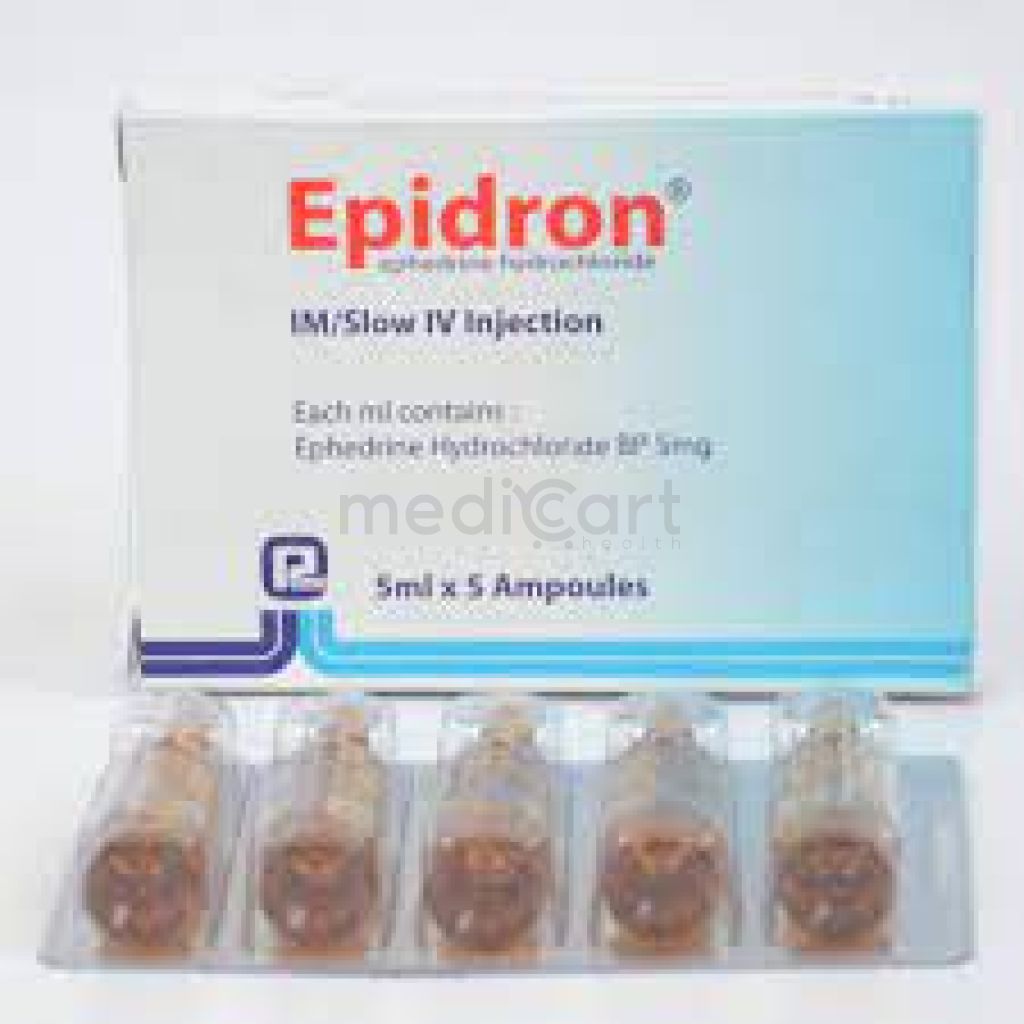

Epidron 25mg/5ml
Injection
Pack Size :
5 Bottle x 1 Packet
Generics :
Ephedrine Hydrochloride
Manufacturer :
Renata Limited
Best Price *
TK
60.25
* Delivery will be done in Dhaka city only.
Alternative Product
More Information About - Epidron 25mg/5ml
Description
Generic Name
Ephedrine HydrochloridePrecaution
Ischaemic heart disease, hyperthyroidism, diabetes mellitus, hypertension, angle-closure glaucoma, renal impairment; prostatic enlargement; pregnancy, elderly. Lactation Unknown if excreted in breast milkIndication
Bronchial asthma, Hypotension, Diabetic neuropathic oedemaContra Indication
Hypersensitivity. Hypertension, thyrotoxicosis, BPH. Lactation.Dose
N/ASide Effect
Gastrointestinal disorders: Nausea, vomiting Cardiac disorders: Tachycardia, palpitations (thumping heart), reactive hypertension, bradycardia, ventricular ectopics, heart rhythm/rate variability Nervous system disorders: Dizziness Psychiatric disorders: Restlessness Potentially Fatal: Delusions, hallucinations. Seen with hypersensitivity and overdosage. Acute CNS and CVS stimulation presenting as vomiting, fever, hypertension, psychosis. Cardiac arrhythmias.Pregnancy Category
Name : Not Classified
Description
FDA has not yet classified the drug into a specified pregnancy category.Mode of Action
Ephedrine has both alpha- and beta-adrenergic acitivity with pronounced stimulating effects on the CNS. It increases cardiac output, induces peripheral vasoconstriction, bronchodilation, reduces intestinal tone and motility, and relaxes the bladder while contracting the sphincter muscle. It also has stimulant action on the resp center and dilates the pupil witho affecting light reflexes.Interaction
Reduces antihypertensive effect of bethanidine and guanethidine. May increase clearance of dexamethasone. Increased incidence of adverse effects when used with theophylline. Potentially Fatal: Severe HTN when combined with MAOIs or withi 2 wk of discontinuance of MAOI treatment. Increased risk of arrhythmias with cardiac glycosides, quinidine or tricyclic antidepressants. Increased vasoconstriction or pressor effects with ergot alkaloids or oxytocin.Pregnancy Category Note
Pregnancy Ephedrine crosses the placenta; used at deliver for prevention and/or treatment of maternal hypotension associated with spinal anesthesia Fetal/neonatal adverse reactions Cases of potential metabolic acidosis in newborns at delivery with maternal ephedrine exposure have been reported in the literature These reports describe umbilical artery pH of ?7.2 at the time of delivery Monitor newborn for signs and symptoms of metabolic acidosis Monitoring of infant?s acid-base status is warranted to ensure that an episode of acidosis is acute and reversible Lactation Unknown if excreted in breast milkAdult Dose
Oral Acute bronchospasm Adult: As ephedrine HCl: 15-60 mg tid. Max: 150 mg/day. Diabetic neuropathic oedema 30-60 mg 3 times/day. Elderly: Initial: 50% of adult dose. Parenteral Reversal of spinal or epidural anaesthesia-induced hypotension Adult: As ephedrine HCl: 3-6 mg by slow IV inj every 3-4 min as required. Max total dose: 30 mg. Elderly: Same as adult dose.Child Dose
Oral Acute bronchospasm Child: As ephedrine HCl: 1-5 yr 15 mg tid; 6-12 yr 30 mg tid; >12 yr Same as adult dose. Parenteral Reversal of spinal or epidural anaesthesia-induced hypotension Child: 0.5 mg/kg or 16.7 mg/m2 4-6 hrly by SC or IM inj or alternatively, 0.75 mg/kg or 25 mg/m2 4 times daily by SC or IV inj.Renal Dose
N/AAdministration
May be taken with or without food. IV Preparation Must be diluted before administration as an IV bolus to 5 mg/mL by withdrawing 50 mg (1 mL) dilute with 9 mL 0.9% NaCl or D5WDisclaimer
The information provided herein are for informational purposes only and not intended to be a substitute for professional medical advice, diagnosis, or treatment. Please note that this information should not be treated as a replacement for physical medical consultation or advice. Great effort has been placed to provide accurate and comprehensive data. However, Medicart along with its authors and editors make no representations or warranties and specifically disclaim all liability for any medical information provided on the site. The absence of any information and/or warning to any drug shall not be considered and assumed as an implied assurance of the Company.





